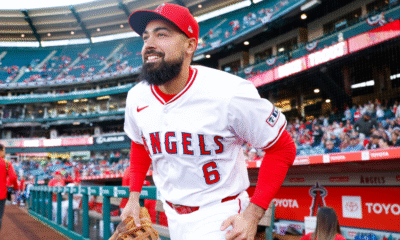
Just last week, we wondered how many Cardinals new president of baseball operations Chaim Bloom would be looking to trade this offseason, how deep he was willing to go to improve this roster long term. And just before Thanksgiving, we found out: He’s ready to start trading right now.
With the Cardinals’ trade of Sonny Gray to the Red Sox for Boston’s No. 5 prospect Brandon Clarke and right-handed pitcher Richard Fitts (plus a player to be named or cash), the exodus of players from St. Louis may just be beginning. Here are five takeaways from Bloom’s first big move.
1. The Red Sox have a rotation workhorse, and that fits their roster
Gray has finished in the top seven in Cy Young Award voting three times in his career (with the A’s in 2015, the Reds in ’19 and the Twins in ’23 — when he finished in second), but the Red Sox are not getting a Cy Young contender. His ERA last year (4.28) was a full run-and-a-half higher than it was in 2023 (2.79), and his WHIP last year (1.23) was the highest since his miserable season with the Yankees back in 2018 (1.50). He’s not your No. 1.
But the Red Sox — unlike the Cardinals when they initially signed Gray — don’t need him to be their No. 1. They have that already in Garrett Crochet. At the worst, Gray is an excellent No. 3 starter, one who gives a ton of innings — 166 or more in each of the past three seasons — and one that can still miss bats: He had 201 strikeouts last year, 11th-most in the Majors. With the Cardinals picking up some of his salary and Gray being a free agent at the end of the year, this deal is mostly without risk for the Red Sox. They’re just simply better — and deeper — because of it.
The Cardinals are reportedly sending $20 million to Boston as part of this trade, which was enough to get the Red Sox’s No. 5 prospect out of it, and also means they’re certainly willing to eat money to improve the farm system. That is not something they have shown much willingness to do in the past. That bodes very well for Bloom and the rest of this offseason, specifically when it comes to trading Arenado, who has $42 million and two years left on his deal.
Presumably, the Cardinals will have to eat more of that deal than they did Gray’s, but considering it’s tough to imagine a scenario where anyone would take him if they didn’t, this is a good sign that they will. This could end up affecting potential trades involving Willson Contreras or even Brendan Donovan as well. It was an open question how much financial freedom on old contracts Bloom would have to work with. It looks like he’s going to have some now.
3. Isn’t this the sort of trade another AL East club should have been making?
Antsy Orioles fans, after the trade of Grayson Rodriguez, are desperate for some starting pitching, and Gray is someone who made a ton of sense for them. After all, they just traded for Taylor Ward, who, like Gray, has just one year left on his deal; getting Gray would be yet another sign they were all-in on 2026, that the front office understands the importance of this specific season.
And while the Orioles might have been hesitant to dig too deep into the farm system, they could, theoretically, have required the Cardinals to pick up less of Gray’s salary. He’d be a very nice fit on a team looking very, very short on innings right now. Certainly they could have beaten the Sox’s offer if they’d have really wanted to, right?
If you’re a Red Sox fan, perhaps this is encouraging, as Baltimore is a team you are battling for a playoff spot.
4. It’s starting to look like a rebuild in St. Louis
Not that most people — including Cardinals fans — were expecting the Cards to be flooring it in 2026, but if anybody thought the Cardinals were all-in for 2026, they might want to rethink things.
All told, Gray would have been a useful player for the Cardinals this year even if they weren’t going all out to win, merely by being a reliable starter every five days. The Cardinals have none of those now. Their ace, at this moment, is probably Matthew Liberatore, who threw 151 2/3 innings but seemed to run out of gas as the year went along and is still only 26. After that? Andre Pallante had a 5.31 ERA last year, Michael McGreevy and Kyle Leahy have started a combined 20 games in their careers and the fifth starter is … uh … well, perhaps the newly acquired Fitts (who had a 4.83 ERA in 10 starts last year) is a sign that the Cardinals don’t really have a rotation right now. They may sign a couple veterans to a one-year deal or two, but this doesn’t appear to be a rotation that will blow teams away.
5. The perception of the Cardinals is changing
A big part of the Cardinals’ success over the last two-plus decades has been tied to the notion that players do in fact want to play there. Mark McGwire, Scott Rolen, Jim Edmonds, Matt Holliday — the Cardinals have had tons of players they brought in and were able to hold onto because the Cards won all the time and would try to compete every year. That was actually one of the main reasons Gray gave for signing with the Cardinals in the first place.
It’s tough to make that argument anymore, not with the Cardinals trading away a guy who signed here specifically because he wanted to compete every year. That’s not what 2026 is going to be. But what Bloom is trying to do is put together the next perennial contender, the next version of the Cardinals that wins every year. The Cardinals are taking a step backward to take several steps forward. Maybe it’ll work, and maybe it won’t. But it’s difficult to argue it wasn’t necessary.
Source link













